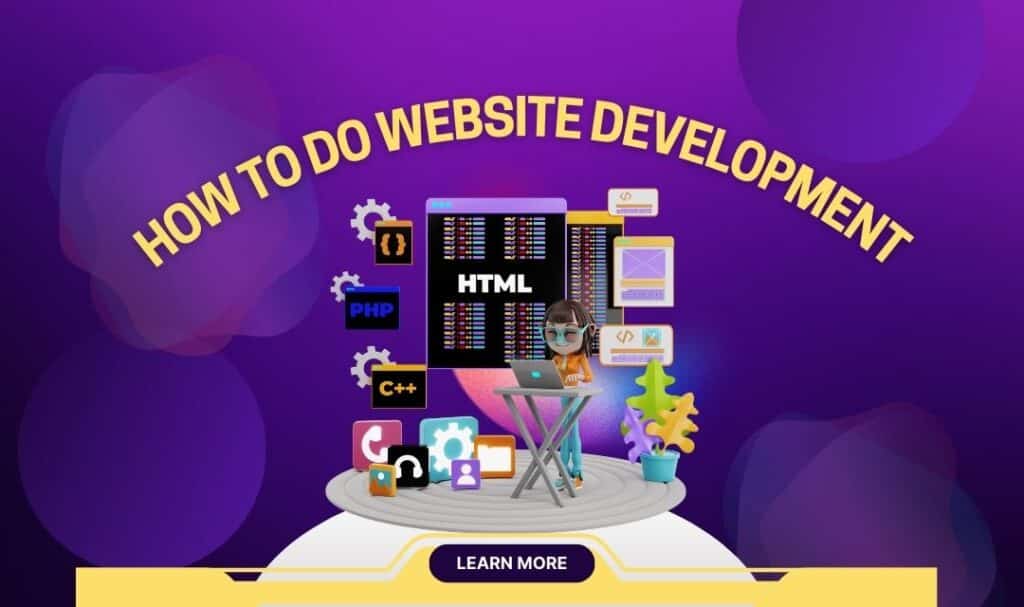How to Do Website Development
Website development is the process of building, coding, and maintaining a website to ensure that it functions smoothly and meets user expectations. Whether you’re creating a personal blog, business website, e-commerce store, or web application, understanding website development is essential.
In this detailed guide, we will walk you through everything you need to know about website development, from planning and designing to coding and launching your site.
1. What is Website Development?
Website development involves coding and programming to create a website that users can interact with online. It includes everything from designing the structure and writing the code to handling databases, security, and performance optimization.
📌 Types of Websites:
✔ Static Websites – Simple sites with fixed content that don’t change dynamically (e.g., personal blogs, portfolios).
✔ Dynamic Websites – Interactive sites with changing content (e.g., e-commerce stores, social media platforms).
✔ Web Applications – Advanced websites with complex functionalities (e.g., Facebook, Gmail).
📌 Types of Web Development:
✔ Frontend Development – Works on the user-facing side of the website (HTML, CSS, JavaScript).
✔ Backend Development – Manages the server-side, databases, and functionality (PHP, Python, Node.js).
✔ Full-Stack Development – A combination of both frontend and backend development.
2. Steps to Develop a Website
Website development involves multiple steps and phases. Below is a structured approach to developing a website from scratch.
Step 1: Plan Your Website
Before you start coding, you need to plan the website’s purpose, features, and target audience.
📌 Key Considerations:
✔ What is the purpose of the website? (E.g., blog, e-commerce, portfolio)
✔ Who is the target audience? (E.g., businesses, students, tech enthusiasts)
✔ What pages will the website include? (E.g., Home, About, Contact, Services)
✔ What features are needed? (E.g., login system, payment gateway, contact form)
📌 Create a Site Map:
A site map is a rough blueprint of the website structure. For example:
- Home
- About Us
- Services
- Blog
- Contact
💡 Tools for Planning:
✔ Notion, Trello – For project management.
✔ Google Docs, MindMeister – For brainstorming ideas.
Step 2: Choose a Domain Name & Hosting
A domain name is your website’s address (e.g., www.example.com). Hosting is where your website files are stored.
📌 How to Choose a Good Domain Name:
✔ Keep it short and easy to remember.
✔ Use keywords related to your business.
✔ Avoid numbers and hyphens.
✔ Choose a .com, .net, or .org extension for credibility.
📌 Popular Domain Registrars:
✔ GoDaddy
✔ Namecheap
✔ Google Domains
📌 Choose a Hosting Provider:
Hosting stores your website’s files and serves them to visitors.
✔ Shared Hosting – Best for beginners and small websites (e.g., Bluehost, Hostinger).
✔ VPS Hosting – More power and flexibility (e.g., SiteGround, A2 Hosting).
✔ Cloud Hosting – Best for scalability and speed (e.g., AWS, DigitalOcean).
💡 Tip: If you’re using WordPress, look for hosting providers with one-click WordPress installation.
Step 3: Design the Website Layout (UI/UX)
Before coding, design the website layout.
📌 Steps to Design a Website:
✔ Wireframing – Create a basic sketch of the website layout.
✔ Mockups – Use tools like Figma or Adobe XD to create a visual design.
✔ Prototyping – Create an interactive version before coding.
📌 Best UI/UX Design Tools:
✔ Figma – Free and great for team collaboration.
✔ Adobe XD – Advanced prototyping.
✔ Sketch – Mac-based design tool.
Step 4: Develop the Website (Frontend & Backend)
After designing, start coding the website.
Frontend Development (User Interface & Experience)
Frontend developers convert the design into a real website using:
✔ HTML (Structure) – Creates the basic layout.
✔ CSS (Styling) – Adds colors, fonts, and responsiveness.
✔ JavaScript (Interactivity) – Enables animations, sliders, and buttons.
📌 Example of a Simple Frontend Code:
<!DOCTYPE html>
<html lang="en">
<head>
<meta charset="UTF-8">
<meta name="viewport" content="width=device-width, initial-scale=1.0">
<title>My Website</title>
<link rel="stylesheet" href="styles.css">
</head>
<body>
<header>
<h1>Welcome to My Website</h1>
</header>
</body>
</html>
📌 CSS for Styling:
body {
font-family: Arial, sans-serif;
background-color: #f4f4f4;
}
h1 {
color: #333;
text-align: center;
}
📌 Popular Frontend Frameworks:
✔ Bootstrap – Prebuilt CSS components.
✔ Tailwind CSS – Utility-based styling.
✔ React.js – Interactive UI library.
Backend Development (Functionality & Database)
Backend developers make the website dynamic and functional using:
✔ Programming Languages: PHP, Python, Node.js.
✔ Databases: MySQL, MongoDB, PostgreSQL.
📌 Example of a Simple Backend Code (PHP & MySQL):
<?php
$servername = "localhost";
$username = "root";
$password = "";
$dbname = "my_database";
// Connect to database
$conn = new mysqli($servername, $username, $password, $dbname);
// Check connection
if ($conn->connect_error) {
die("Connection failed: " . $conn->connect_error);
}
echo "Connected successfully";
?>
📌 Popular Backend Frameworks:
✔ Laravel (PHP) – Great for web applications.
✔ Django (Python) – Secure and scalable.
✔ Express.js (Node.js) – Lightweight and fast.
Step 5: Test and Debug the Website
Before launching, test for errors.
📌 Key Testing Areas:
✔ Mobile Responsiveness – Check on different devices.
✔ Loading Speed – Use Google PageSpeed Insights.
✔ Security Testing – Protect against hacks.
💡 Best Testing Tools:
✔ Google Mobile-Friendly Test.
✔ Browser Developer Tools (Chrome DevTools).
Step 6: Launch the Website
Once testing is done, upload your website to the hosting server.
📌 Steps to Launch a Website:
✔ Upload files via cPanel or FTP (FileZilla).
✔ Configure domain settings.
✔ Enable SSL certificate for security.
💡 Tip: Use Google Search Console to submit your website for better SEO rankings.
Final Thoughts
Developing a website requires planning, designing, coding, and testing. By following these steps, you can create a fully functional and visually appealing website.
✅ Summary of Steps:
✔ Plan the website (domain, hosting, structure).
✔ Design the UI/UX using Figma or Adobe XD.
✔ Code the frontend with HTML, CSS, JavaScript.
✔ Develop the backend with PHP, Python, or Node.js.
✔ Test and optimize performance before launch.
💡 Need help with website development? Let me know! 😊



